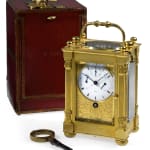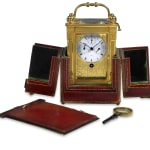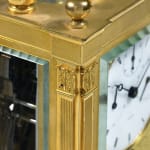Breguet Neveu Compagnie
Further images
Provenance
Sold by Breguet to Monsieur le Comte Wladimir Komar, 11thJune 1853 for 4000 francs.
Literature
Derek Roberts, “Carriage and other Travelling Clocks”, 1993, p. 34, pl. 2-7 a-c, illustrating this clock.
An extremely important, rare and large gilt bronze grande and petite sonnerie striking carriage clock with quarter-repeat, pull-wind alarm and calendar by Breguet Neveu Compagnie à Paris, signed on the dial Breguet, also signed and numbered below on the foliate engraved gilt mask Breguet no. 5017 and further signed and numbered on the movement Breguet Neveu & Compagnie, no. 5017, accompanied by the original gold-tooled red Moroccan leather travelling box, the original Breguet key and a Breguet certificate numbered 4029, noting that the clock was sold on 11thJune 1853 to “Monsieur le Comte Wladimir Komar le No5017 Pendule de voyage en bronze doré à grande et petite sonnerie au passage, répétition des quarts et réveil, avec le quantième du mois, dans son écrin d’origine en maroquin rouge. Pour le Prix de 4000 francs.”
The white enamel dial by Droz with Roman numerals and an outer minute track, enclosing three subsidiary dials for the seconds (at top), the days of the month (lower left) and the alarm (lower right). The rectangular brass movement with a large single double-ended going barrel driving the going and striking trains, horizontal gilded platform with lateral lever escapement, three-arm bimetallic compensation balance with temperature adjustment screws, with parachute on the top pivot, blued-steel Breguet balance spring, index regulator, striking and quarter-repeating work visible on the back plate, the bells mounted within the base, with pull-wind alarm and repeating buttons on the top of the case and petite/grande sonnerie and silence/sonnerie selection levers on the edge of the dial. The heavy multi-piece cast and engine turned gilt bronze case of exceptional quality, with Corinthian pilasters, glazed sides, back and front doors, with an oval glazed aperture on the top to view the escapement, surmounted by four ball finials, a scroll handle with ball supports, foliate pierced base for sound transmission on chased bun feet
Paris, made 1831-32
Height 15 cm, width 11 cm, depth 8 cm.
The name of Breguet is synonymous with the highest quality carriage clocks of which the present example is no exception. According to the Breguet workbooks, this clock was made between 1831 and 1832 and remained in the company’s stock for the next two decades. An inventory of 1stJanuary 1833 records that it then had an engine-turned silver dial; this was then updated when replaced by a new enamel dial by Droz and an engraved dial plate, as noted on 22nd December 1841. According to the repair books it was overhauled on 5th September 1853, at the request of Count Vladimir Komar, who had recently purchased the work. The history of the carriage clock industry is indebted to the most esteemed clockmaker Abraham-Louis Breguet (1743-1823) whose first carriage clock was delivered to Napoleon Bonaparte in 1796 shortly before he embarked on his Egyptian campaign. Breguet’s ability for quality and innovation earned him international recognition.
Even after his death the firm’s outstanding repute continued and for this reason was patronized by royalty, aristocracy and leading society figures. When A-L Breguet set up his business circa 1775 in the heart of the Parisian clockmaking district at Quai d’Horloge his business was initially known as Breguet and remained so until he was joined by his son Louis-Antoine Breguet (1776-1858) in 1807 when it was renamed Breguet et Fils. When Louis-Antoine retired in the early 1830s his son Louis-Clement-François (1804-83) went into partnership with one of his relatives to form Breguet Neveu Compagnie. Louis-Clement-François was then succeeded by his son Antoine-Louis, who as the last family member wanting to continue the business then took his English foreman Edward Brown into partnership and in 1870 Brown became the proprietor of the esteemed House of Breguet. Following the formation of Breguet Neveu & Cie, the firm enjoyed an illustrious patronage; for instance in December 1832 they sold a Grande sonnerie carriage clock to Count Anatole Demidoff; in August 1834 Breguet sold a Pendule Sympathique to King Louis-Philippe for 600 francs and the following year another carriage clock to Madame Baudin, which was later owned by Sir John Prestige and is now in the British Museum, London.









